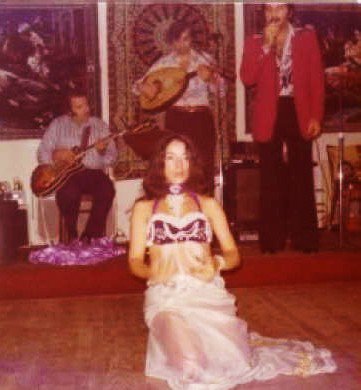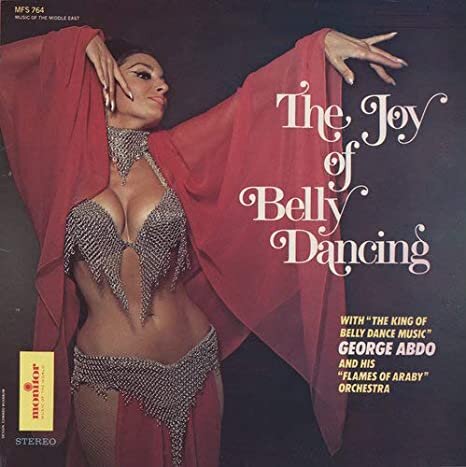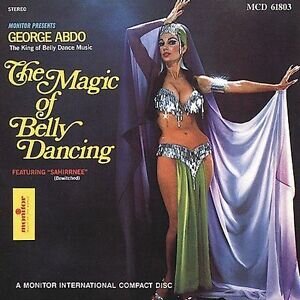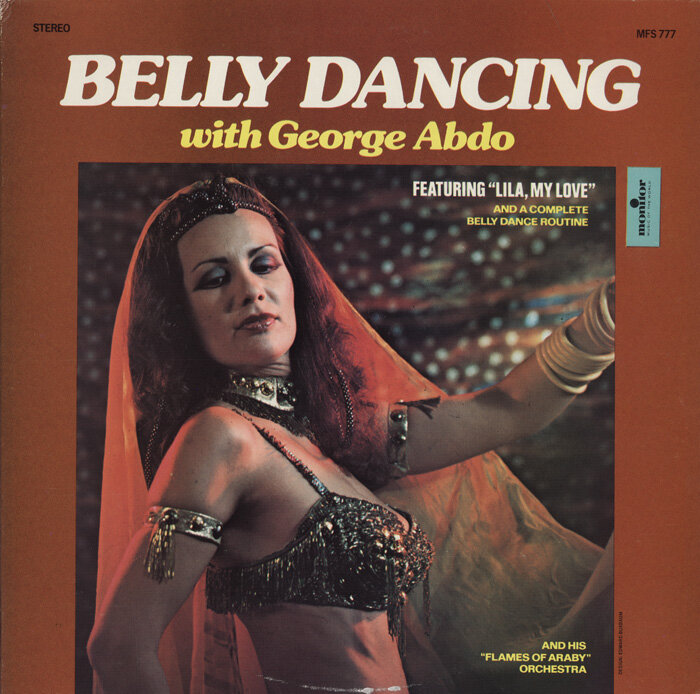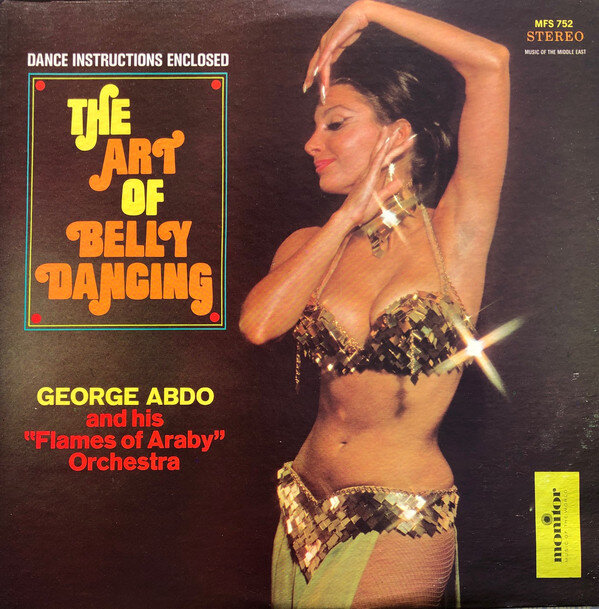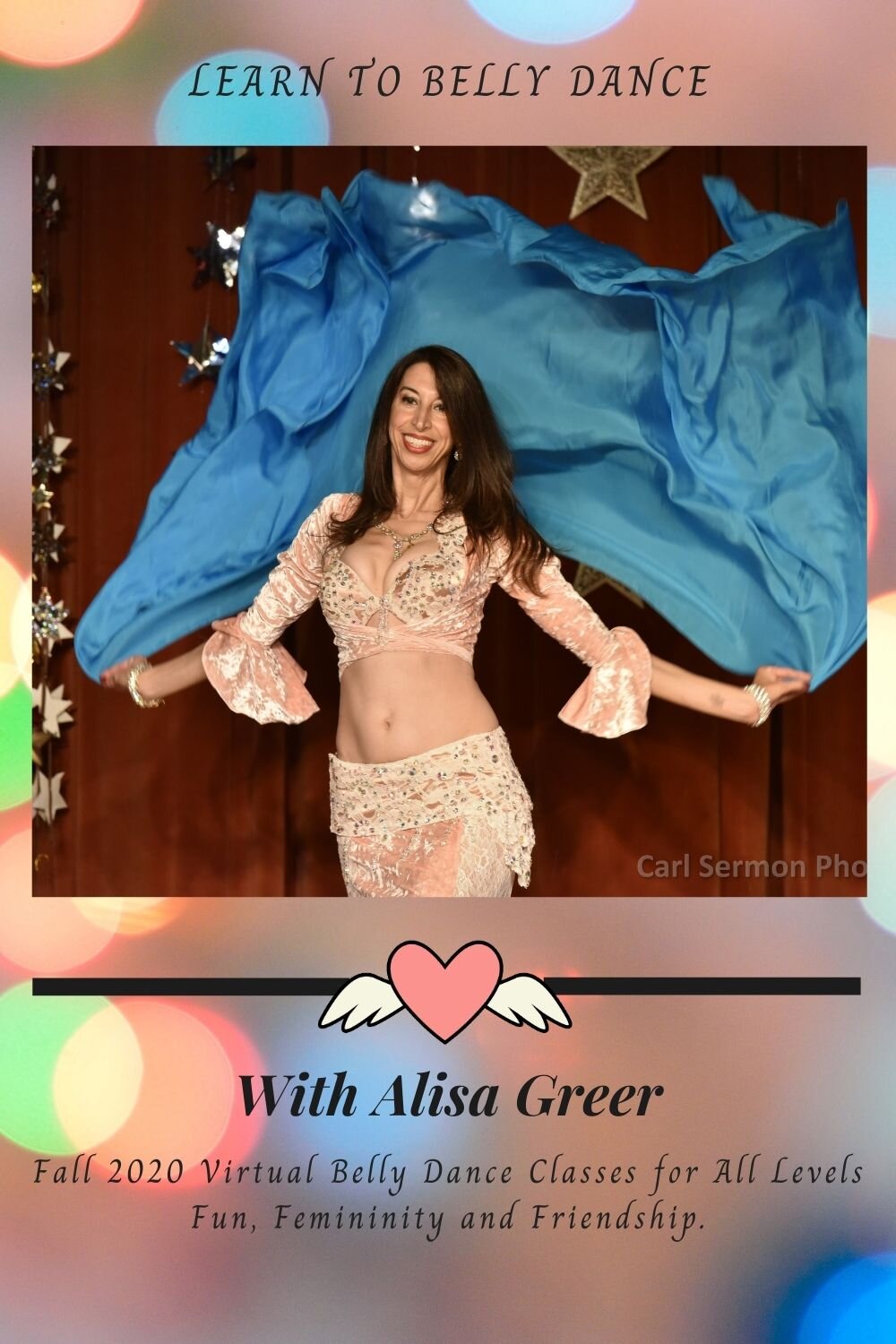I am very excited to share today’s post.
Today we are travelling back in time to the early days of American belly dance and the US Middle Eastern nightclub scene of the 1970s and 1980s. During this time, belly dance bands were made up of a mix of Arab, Turkish, Greek and Armenian musicians. Each contributed the songs of their culture to the show, the music they grew up listening to, creating an exotic blend of music. And the belly dancers of the time entertained their audiences to this international mix of sounds.
Today we refer to the style of belly dance done at that time as American Cabaret. Back then, when information about how the dance is performed in the cultures from which it comes was much less available to dancers here, it was simply called belly dance. My mother was a professional belly dancer during this era, and I’ve been mesmerized by it since I can remember.
Ed Melikian and George Abdo’s Flames of Araby Orchestra
I was beyond thrilled when the Armenian oud player Ed Melikian said he would share his story with me, and to be honest I am still walking on air. Ed was a member of George Abdo’s Flames of Araby Orchestra. George Abdo’s records have been popular with belly dancers since the 1970s and are still loved and used by many to this day. Since my mother and aunt were both professional belly dancers, we owned several George Abdo records and I grew up dancing around our living room in my mother’s chiffon scraps to Ed’s oud playing. It was such an honor to speak with him about his career.
Ed has had a long career playing for belly dancers, and he spent five of those years with the Flames of Araby Orchestra. They played at the storied Averof nightclub in Cambridge MA, which featured live music and belly dancing seven nights a week. Ed remembers the Averof’s mixed crowd- Turks, Arabs, Greeks, Armenians and Americans, including the famous Red Sox pitcher Luis Tiant and his wife- lining up outside waiting to get in. The crowd could turn over 2 or 3 times a night. The belly dancers would make an evening of it as well, coming in before their shows to eat dinner and take part in line dancing, then dancing a 30 or 35 minute set and staying afterwards to enjoy the rest of the night.
Ed playing the Oud at the Averof with Leon Manoogian on Dumbek, Ted Vartabed on Violin, with Dance Team Kasim and ZaBeth- Photo Courtesy of Ed Melikian
Ed playing with George Stringos and George Abdo for dancer Samia - Photo Courtesy of Ed Melikian
Ed Melikian at the Averof in the 1970s - Photo Courtesy of Ed Melikian
And for those who weren’t in the Boston area to catch one of these nightly live shows, there were records. George Abdo recorded many albums, and Ed played on these as well. These records were released on the Monitor label (the rights were later acquired by Smithsonian, who released a compilation CD) and were popular throughout the United States and internationally as well, which meant that the Flames of Araby also went on tour and were often treated like rock stars in the places they visited. Ed remembers one stop in Dallas in 1980, in the days of more relaxed airport security and before winding tubes led passengers from the plane to the airport. As the band stepped out of the plane, they were greeted by fully costumed belly dancers performing on the tarmac to celebrate their arrival.
Ed experienced a different kind of greeting upon arrival in Honduras, where a group of wealthy resident Palestinians had invited the band to play. The airport where they landed consisted of a sole runway lined by howitzers. Seeing them, Ed asked George what on earth he’d gotten them into, and he remembers that stepping out of the plane was like stepping into a steam bath. But the band was treated extremely well by their hosts. They played in a church hall that held a thousand people and it was packed with an appreciative audience. Though Ed noted that, because of the extreme humidity, it was a year or longer before he could tune his oud correctly.
Learning to Play
Ed grew up in an Armenian neighborhood in Worcester, MA. He loved music from a young age and was captivated by his father’s 78 records of Armenian and Turkish music as a boy. He especially loved the records of the famed blind Armenian-Turkish musician Udi Hrant Kenkulian. He would listen to these records again and again with friends and eventually as they got older, they picked up instruments and tried playing along. Most impressively Ed is completely self taught as a musician as his parents, survivors of the Armenian Genocide as well as the Great Depression, simply wanted their son to get a good education and stable job.
On Ed’s 9th or 10th birthday, his sister gave him a toy ukulele. Around this time, Ed’s first cousin in Detroit got engaged to an Armenian oud player. He brought his oud with him on a visit to Ed’s family and taught Ed how to play two Armenian songs on the ukulele. A year or two later, a different cousin gave him a mandolin and he transferred what he was learning on the ukulele to that. Eventually he bought his first oud, an Arabic oud for $85. He later bought a Turkish oud made by the renowned Armenian Turkish oud maker Onnik Karibyan, and this is the instrument he played for 40 years, including during his time with George Abdo and for that steamy show in Honduras.
Ed learned to play the initial Arabic oud with his friend Dick Barsamian, who would play the lead while Ed backed him up on a second oud, and then eventually sometimes they would switch. He was consumed with learning to play because he loved the music so much and he would have done anything to be in a band.
And eventually his dream came true. Around 1963/1964 he and his friends got their first job playing Friday nights at the Venus DeMilo nightclub. He and his bandmates would all pile into one station wagon to make the hour trip to the club for their show.
An Armenian Story
Mr. Melikian is a first generation Armenian American. His parents, Sarkis and Paris (Andonian) Melikian came from the city of Sebastia, which is called Sivas in present day Turkey. His mother came from a relatively wealthy family. Her father was a barber who had government officials among his clients. During the Armenian Genocide of 1915, her father was told that they would need to leave the country but that they would not be harmed if they did. They made their way to the United States.
Ed’s father’s family faced different circumstances. They were less well off and his father tended sheep for a Turkish family on the outskirts of the city. This Turkish family helped him hide when the police came looking for Armenians, and they would tell him when it was safe to come out again. Ed’s father never wanted to go into much detail about his ordeal or his escape (for those who may not know, this is not unusual among survivors of the Armenian Genocide). Ed remembers waking up sometimes as a child and hearing his father moaning in the night. He realizes now as an adult that it was most likely a recurring dream brought on by whatever traumas he endured and survived in order to make it out and start his new life.
Ed grew up listening to his father’s 78 records of music from home. Home was Ottoman Turkey, and the music was both Armenian and Turkish because they were Turkish Armenians. Ed plays both Turkish and Armenian songs when he plays for belly dancers.
Playing for Belly Dancers
Ed remembers being on vacation on Cape Cod one summer as a boy with his parents. There was an Armenian band playing live every night at the resort and Ed loved watching the show. But he remembers his parents not letting him go the one night there was going to be a belly dancer performing. He was crushed because he absolutely loved watching the band.
Despite that one episode, Ed does not remember any kind of stigma in the Armenian community associated with playing for belly dancers. And looking back on his career he says he’s really enjoyed his time playing in nightclubs and for belly dancers in part because he’s able to play not only Armenian songs but the Turkish songs he loves so much as well but which aren’t always welcome at strictly Armenian gatherings.
Ed said that George Abdo liked having different ethnicities in his band and that he particularly sought out Armenian musicians because of their willingness to learn different styles and their ability to “play anything”. This stems from the nightclub scene of the 1960s on Eighth Avenue in NYC, which were havens for Armenians, Greeks and others forced to flee their homelands. Ed’s ability to play the maqams of the Americanized Arabic songs in George Abdo’s repertoire comes from his familiarity with Turkish music, which also has them. That said, Arabic and Turkish maqams differ and Ed did have to learn the difference. George told him to have Fred Elias- who was a master violinist and expert at other stringed instruments including the oud- teach him, which he did.
Often belly dancers would arrange for George Abdo and the Flames of Araby to make a tour stop in their town as part of what we would probably now call workshops. During the Dallas/Fort Worth trip mentioned earlier, Ed remembers playing in a large hotel ballroom for a crowd of 2000. And he also remembers that the following night, he and the band went to see the famed Greek group Trio Bel Canto who were playing at a venue in Dallas. They were so great they wound up throwing every cent they’d earned the night before onto the stage in tips.
Today
Ed’s love of music- all different kinds of music- has not diminished over the years and he’s still playing for dancers too. He played a regular live music belly dance show at Sahara Restaurant in Worcester for over a decade. And right up until the pandemic he was playing regular live shows at El Basha in Worcester, MA. The shows include belly dancing as well as line dancing and bring in a diverse crowd.
He gave me a breakdown of how he structures a belly dance show:
An opening number - perhaps Aziza or the Turkish songs Istemen Babajim or Siseler, or something else in 2/4 time
Slow rhumba for veil work, here he will often sing an Armenian song called Oror or a song called Yarus which is originally an Israeli song but long ago someone translated the lyrics into Armenian. The band members will solo from here.
The next section will be a more uptempo baladi with more solos and builds in speed
Then they will slow down or stop altogether before changing into a chiftiteli with solos and the possibility for floor work. From there the band will ease there way back to a faster tempo and 2/4 time
Drum solo
The final number will be 9/8 Kashlima or something in 2/4 depending on the preference of the dancer. Here the dancer can go out and collect tips if they haven’t already been strewn upon her by the adoring audience
Here is a lovely clip of a past show featuring the dancer Akasha.
Ed Melikian - Oud & Vocals, Richard Kazarian - Clarinet, David Ansbigian - Guitar, Arthur Chingris - Drums, Steven Surabian - Def. - Live at the Sahara
And here is another clip from El Basha featuring line dancing.
Pre-pandemic Ed also did a 2-hour radio show each month featuring a wide variety of Middle Eastern music on WCUW 91.3 FM. I can’t wait to tune in when it’s safe for him to resume.
And there is good news for those of us not close enough to hear Ed play live- he brought out a lovely album of belly dance music this year. In addition to Ed’s oud playing it features Mal Barsamian on Alto Sax and Mary Anna Brown (Phaedra) on finger cymbals, as well as Rich Kazarian - Clarinet and Def (Tambourine), Gary Kashmanian - Dumbek, Ken Kalajian - Guitar, Bass Guitar and Jay Baronian - Dumbek/Vocals. Physical copies of the CD can be bought through Ed by emailing oudplayer@hotmail.com, and digital copies are available for purchase on Amazon and iTunes. The album is also streaming on Spotify. If you would like something gorgeous and fresh to liven up your dance, I highly recommend it!
Writing this has been such a labor of love and I am very grateful to Ed for sharing his experiences and his music with us. I'll end this post the way it began, dancing in my living room to the beautiful oud of Ed Melikian.
One last note, Ed and I began talking weeks ago at a more peaceful time and this post was meant to be a celebration of artistry and of different cultures coming together to share and create. It was not intended to be political. However, the situation has changed drastically for the Armenian people in those few weeks, and I wouldn’t feel right if I didn’t mention that. I encourage everyone to please take a moment to read a bit about it and help the Armenian people if you can.
And you can subscribe to my Monthly Newsletter to be notified of future articles as well as class information. I never share your email address.




